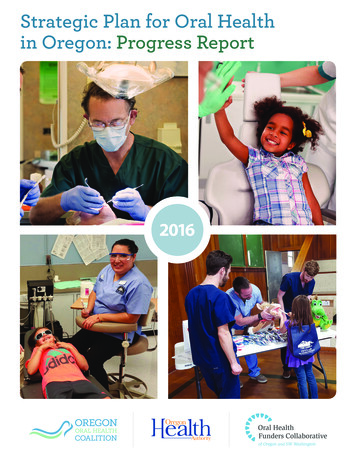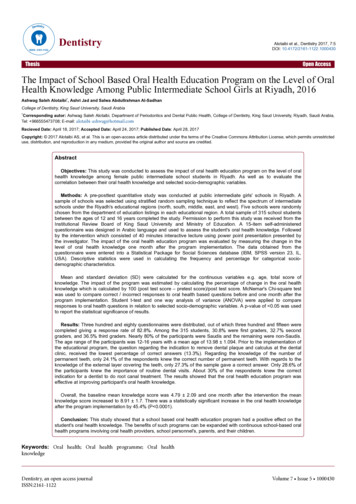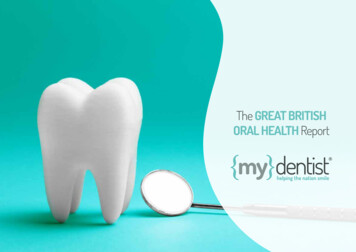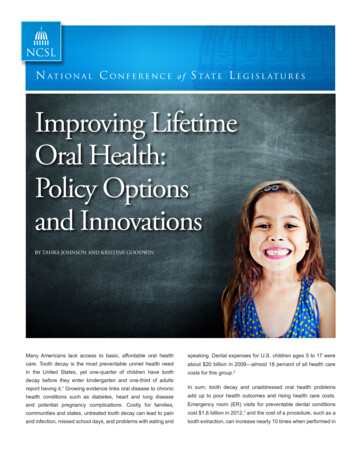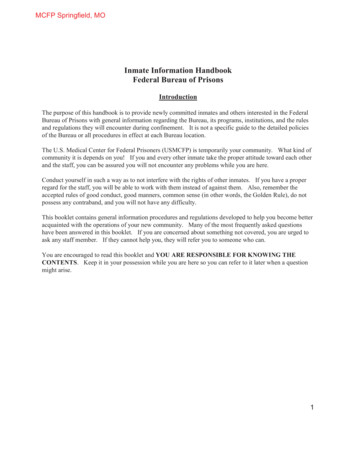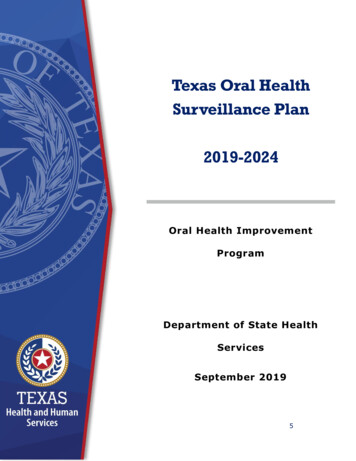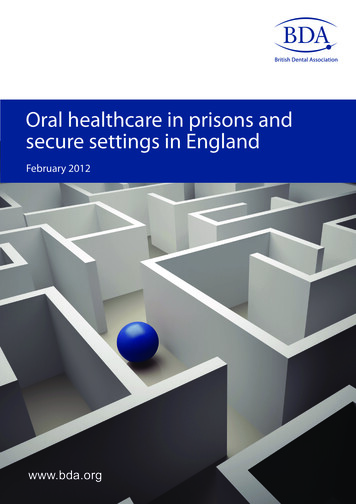
Transcription
Oral healthcare in prisons andsecure settings in EnglandFebruary 2012www.bda.org
Dentists and dental teams involved in the treatment of prisonersand those in secure settings must be supported to provide thelevels of care needed by their populations.What is the problem?Providing dental services in a prison environment presents dentists with many uniquechallenges, including concerns about threats to personal security, inability to move freely,and the requirements to deliver modern dentalservices in an environment that, in many cases,Secure settings are prisons,requires modernisation. Much of what is taken foryoung offenders’ institutes andgranted in high street practices may be difficult tosecure psychiatric hospitals.implement, while on the other hand practitioners findthemselves bound by an additional prison rule book.Ensuring compliance with HTM 01-05 and other clinical guidelines in a prison environment with itsstrict security procedures, for example, represents an unusual, and not insignificant, challenge.Why is it a problem?Prisoner profilePrisons are running at high capacity, with the prison population continuing to rise. Population incustody figures for February 2011 (England and Wales) showed there were 84,469 people incustody at the beginning of February and by the end of February there were 85,206, an increaseof 737 (HM Prison Service Feb 2011). The picture in Scotland is similar according to the AuditorGeneral for Scotland where “prisoner numbers in Scotland have increased significantly since2000/01, with the highest ever number of 7,700 recorded in April 2008. The number of prisonersis projected to increase by almost 20 per cent by 2016/17” (Audit Scotland 2008:05).Many prisoners suffer from mental health issues or learningdifficulties, a higher proportion than the general population(Department of Health 2003:06). The prison populationis a high needs yet vulnerable group with complex oralhealth needs which can be complicated by drug andalcohol addiction and dependence problems. In 2007,the World Health Organization reported that “prisonerswith substance misuse problems are likely to reporttoothache very soon after entering prison, as any opiatedrugs they took suppressed the toothache” (2007:148). Insupporting prisoners through drug and alcohol rehabilitationprogrammes, the dental team is well placed to be part ofthe multi-disciplinary healthcare team.An ageing populationThe already complex needs of the prison population are exacerbated as prisoners enter oldage. The prison environment has a significant impact on prisoners’ general health, meaningthat prisoners may be 10-15 years olderphysiologically than those of the same ageI recently met a womanoutside prison. In addition, older prisonersin Holloway who hadsuffer accelerated biological ageing, whichhas severe implications on oral as well asassaulted a member ofgeneral health (National Association ofstaff and it turned out she had donePrison Dentistry UK 2010:1). “People overit deliberately to prolong her stay60 are now the fastest-growing age groupin the prison system in Englandas she was mid-way through dentaland Wales.treatment and it was the first timeIn the last ten years, the number ofshe had been to a dentist.”sentenced prisoners over 60 has grownCrook 2009:31by almost 250 per cent” (Hayes & Shaw2011:38). Heath and Iqbal report that “it isrecognised that the prison population is generally from marginalised communities that havepoor access to primary healthcare” (2007:42). This combination, of the ageing prisoner and pooraccess to healthcare in earlier life brings additional challenges to an already stretched prisonhealthcare system.Prison facilities and the provision of servicesThe prison environment often presents additional barriers to the delivery of appropriate andeffective care to an already high-need population. The prison population often present with highneeds, as emergency and urgent cases, and access or following through with care as a prisonerisn’t always easy. The high turnover of prisoners in some institutions, particularly in remand orshort-stay institutions, where short sentences or frequent transfers between facilities mean coursesof treatment can go unfinished. WhenWhile treating this particular prisoners are transferred betweenfacilities, this has implications for thepopulation provides manyoral and general health of the patient,the workload of the receiving dentist atinteresting challenges,thethe next institution and the additionalproblems of providing efficientcost to the NHS of commencinghealthcare within the many restrictions a new course of treatment wheredental records are not transferredimposed by the prison system canwith the patient. On 12 April 2011, themake it a frustrating experience.”Department of Health in England issuedDr J Husband 2010a press release about the improvementsin prison health as a result of a nationalIT system in prisons and young offenders’ institutes. The project aims to improve continuity of carefor prisoners moving between prisons because of the installation of a new system containing upto date medical information, thus liberating clinicians to concentrate on patient care. We hope thatadvancements in IT will mean improved transfer of dental patient records, providing that the new
technology can be integrated into existing IT systems and includes dental health records.The transient nature of the prison population hampers continuing dental care as well as providinga constant supply of new high needs patients. Given these issues, the challenge of providingeffective dental care to prisoners is highlighted in the model shown by Harvey et al (2005:07).Needs Difficulties in providingcontinuity of care Interupted treatments andnon-attendance Department of HealthLong standing neglect in oral health NHS Commissioning Board Routine checks and health promotiongiven less priority due to high needs Prison authorities Drug misuse and smoking increasedental health needs Dental Care Providers Nutrition Postgraduate DeanshTurnover of prison populationMinistry of Justice Demanding consumers High levels of needWaiting timesResourcesSupplyh The BDA makes these recommendations to: hDemandWhat is the solution?h Availability of dental care products Outdated facilities and equipment Lack of space Lack of funding for health promotionand additional sessions Insufficient staff for treatment and for security Staff training and quality assurance Shortages in dental time Sessions shortened bysecurity procedures Recruitment and retention Quality of dental care Availability of routinetreatment in some prisons Availability of oral healthpromotionHarvey et al (2005:07)Challenges to delivering careDentists and dental teams working in secure settings are committed to providing this importantservice but are often not appropriately supported to deliver the care needed by their patients. TheNAPDUK guide to working in prisons suggests that “sometimes prison dentists and can facedifficult dilemmas when existing prison regimes and safe clinical practice do not coincide and theirethical obligations as regulated professionals meant that they may have to challenge traditionalprison practices” (NAPDUK 2010:i). It is important the increased regulation does not impinge onpatient care particularly for the vulnerable patients found in prison and secure settings. It is alsoimportant that to ensure this, practitioners in such environments receive adequate support toenable the high standards of infection control and clinically safe environments are retained but in amanner suitable to the prison environment.BDA survey resultsIn 2010, the BDA embarked on a project across the UK to gather evidence from prison dentistsregarding the challenges of working in the prison environment. On average, over half of thosesurveyed had worked in prison dentistry for between six and 15 years, showing a dedication totreating these vulnerable members of society (BDA 2010:12). The survey results highlightedthat 64 per cent of respondents said they would like to receive more training particularly aroundsecurity or clinical training on patients with substance abuse issues. The clear message from thesurvey was that the delivery of dentistry within the prison structure was in many ways different tohigh street dentistry and care was not as easily deliverable in secure settings where infrastructurewas sometimes built pre 1900, and where security (for obvious reasons) was inflexible.1. The Department of Health and the NHS Commissioning Board should ensure that prisondental healthcare services are suitably commissioned and/or contracted to ensure appropriatedental care for all.2. The Ministry of Justice, the Department of Health, the NHS Commissioning Board, Prisonauthorities and dental care providers should make clear the NHS offer and provide assistanceto dentists if clinical decisions are not understood or agreed with by the patient.3. The NHS Commissioning Board and the Department of Health should put in place anagreement on the appropriate waiting time for initial examination, ongoing routine care andaccess to emergency provision with an outline for measuring these times.4. The Department of Health and the NHS Commissioning Board should develop an appropriatesystem for the transfer of patient oral health history in a timely manner when the patient ismoved to ensure continuing care to be available to prisoners. The Department of Healthrecently committed to improving the transfer of medical records between secure settings, andthe same commitment must be made for dentistry.5. The NHS Commissioning Board should establish a baseline of existing practices to ensurethey are fit for purpose and appropriate resources should be allocated to correct deficiencies.6. The Ministry of Justice and the NHS Commissioning Board should ensure that the dental teamis fully integrated into the prison health team and ensure open channels of communication.7. The NHS Commissioning Board, the Prison authorities and dental care providers shouldensure that all dentists and dental care professionals new to the prison environment shouldreceive a full induction to prison security protocol and given an immediate induction plan.Training on the following should form a mandatory part of the induction process:a. general securityb. personal protectionc. situation de-escalationd. handling difficult prisonerse. understanding the criminal justice system
8. The NHS Commissioning Board and dental care providers should make all clinicians new toprison dentistry aware of the National Association of Prison Dentistry UK handbook, Dentistryin Prisons, which gives comprehensive advice from peers.9. Postgraduate Dental Deans should make available more prison-specific clinical trainingscourses on issues includinga. drug misuse and the impact on oral healthb. alcohol misuse and the impact on oral healthc. dealing with alcoholismd. management of failed/failing dentitione. medical emergencies in the prison environmentf. dealing with complex drug therapyg. treatment planning for the transient population10. The NHS Commissioning Board should ensure that NHS contracts should be awarded in sucha way that they attract superannuation.How do decision-makers implement the solutions?Dentists and dental care professionals working in prisons, young offenders’ institutes andsecure psychiatric hospitals should be supported to deliver the high quality care they want andneed to give their patients. In England and Wales and recently in Scotland, prison dentists areaccountable to two organisations: the NHS and the prison authorities causing confusion for prisondentists in England and Wales about where responsibility for an issue may lay and the dentistbeing “stuck in the middle” (BDA survey 2010:9).The recommendations we make offer a way forward to ensure that practitioners providing care topatients in secure settings are supported to deliver appropriate care.ReferencesAudit Scotland (2008) Managing increasing prisoner numbers in ScotlandAvailable: /nr 080508 prisoner numbers.pdfBDA (2010) Prison dentist surveyAvailable: http://www.bda.org/Images/prison dentist survey report sept 2010.pdfCrook, F. (2009) “Everybody Hurts: The social costs of the failure of prisons”. Perrie Lectures.Prison Service Journal. Issue 186, p29-31.Department of Health (2003) Strategy for Modernising Dental Services for Prisoners in England.Available: http://www.dh.gov.uk/prod consum dh/groups/dh digitalassets/@dh/@en/documents/digitalasset/dh 4068229.pdfDepartment of Health (2011) Press release: Prison health to improve as result of nationalIT system.Available: DH 125986Harvey, S., Anderson, B., Cantore, S., King, E., Malik, F. (2005) “Reforming prison dental servicesin England – a guide to good practice”.Available: PublicationsPublicationsPolicyAndGuidance/DH 4139050Hayes, A., Shaw, J. (2011) “Practice into Policy: The Needs of Elderly Prisoners in England andWales”. Prison Service Journal. Issue 194, p38-44.Heath, L., Iqbal, Z. (2007) “Measuring the health status of prisoners”. Prison Service Journal.Issue 174, p42-44.Available: risonservicejournal/index.asp?id 7534,3124,11,3148,0,0HM Prison Service – Population figures to April 2011Available: ublicationsdocuments/index.asp?cat 85Ministry of Justice – Population figures from April 2011Available: gures/index.htmNational Association of Prison Dentistry UK (2010) “Dentistry in prisons: a guide to working withinthe prison environment”. Stephen Hancocks Ltd, London.WHO (2007) “Health in prisons; A WHO guide to the essentials in prison health”. Eds Møller, L.,Stöver, H., Jürgens, R., Gatherer., A., Nikogosian, H.Available: http://www.euro.who.int/ data/assets/pdf file/0009/99018/E90174.pdf
BDA64 Wimpole Street, London W1G 8YST 020 7935 0875 F 020 7487 5232enquiries@bda.org
Dentists and dental care professionals working in prisons, young offenders' institutes and secure psychiatric hospitals should be supported to deliver the high quality care they want and need to give their patients. In England and Wales and recently in Scotland, prison dentists are accountable to two organisations: the NHS and the prison authorities causing confusion for prison dentists in .

